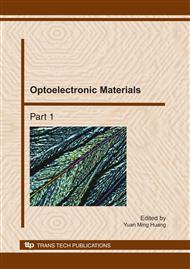p.150
p.154
p.158
p.162
p.166
p.170
p.177
p.183
p.187
Effect of Sputtering Pressure on the Formation of Semiconducting Mg2Si Films
Abstract:
Semiconducting Mg2Si films were fabricated on Si (111) substrates by magnetron sputtering and subsequent annealing, and the effects of sputtering pressure on the Mg2Si film growth were studied. The structural and morphological properties of Mg2Si films were investigated by the means of X-ray diffraction (XRD) and scanning electron microscopy (SEM). The results showed that the Mg2Si (220) main diffraction peak intensity increased and then decreased with the increasing of sputtering pressure. The (220) diffraction peak got its maximum at 3.0 Pa sputtering pressure. The intensity of Mg2Si (200) and (400) diffraction peaks increased rapidly as the sputtering pressure decreased when the pressure was lower than 1.5 Pa. The films prepared at higher sputtering pressure had very irregular microstructures, and the surface of semiconducting Mg2Si films became smoother with the decreasing of the sputtering pressure.
Info:
Periodical:
Pages:
166-169
Citation:
Online since:
November 2010
Authors:
Price:
Сopyright:
© 2011 Trans Tech Publications Ltd. All Rights Reserved
Share:
Citation:


